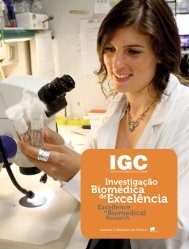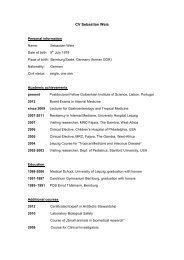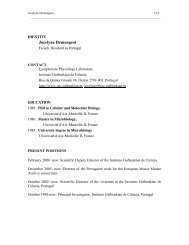organisation - the Instituto Gulbenkian de Ciência
organisation - the Instituto Gulbenkian de Ciência
organisation - the Instituto Gulbenkian de Ciência
- No tags were found...
Create successful ePaper yourself
Turn your PDF publications into a flip-book with our unique Google optimized e-Paper software.
ANTIGEN<br />
PRESENTATION<br />
AND T CELL ACTIVATION<br />
Elisabetta Padovan Research Fellow<br />
PhD in Immunology, University of Padova, Italy, 1994<br />
Group Lea<strong>de</strong>r, Bern University Hospital, Switzerland<br />
Principal Investigator at <strong>the</strong> IGC since 2006<br />
T cells are central actors of antigen-specific immune responses and <strong>the</strong>ir function<br />
is strongly influenced by <strong>the</strong> Antigen-presenting Cells (APC) <strong>the</strong>y directly<br />
interact with. APC control T cell activation also indirectly, by providing cytokines<br />
that are induced by environmental triggers recognised by Pattern Recognition<br />
Receptors (PRR). Although it has long been recognised that PRR on professional<br />
APC instruct <strong>the</strong> cell fate <strong>de</strong>cisions of naïve T lymphocytes, a careful analysis<br />
of how PRR signalling modulates effector memory T cell function, directly and<br />
indirectly through APC, is still missing. By studying <strong>the</strong> crosstalk between Monocyte/Macrophages<br />
and T helper (Th) cells producing IL-17 (Th17) or IFN-γ (Th1)<br />
we aim at dissecting how human Th17 and Th1 responses of healthy donors and<br />
patients become tuned, also <strong>de</strong>pending on <strong>the</strong> presence or absence of PRR<br />
ligands.<br />
HOW PATTERN RECOGNITION RECEPTORS (PRR) SIGNALLING CONTROLS<br />
T LYMPHOCYTES ACTIVATION<br />
Adaptive immunity <strong>de</strong>pends on <strong>the</strong> induction of antigen-specific T cells in central<br />
lymphoid organs, upon priming of naïve T cells by professional Antigen<br />
Presenting Cells (APC) licensed through Toll-like Receptors (TLR). Up to now<br />
it is still poorly known whe<strong>the</strong>r TLR signalling can also influence <strong>the</strong> crosstalk<br />
between APC and CD4+ memory T cells, thus tuning T helper (Th) cell responses<br />
in peripheral tissues. We use imaging techniques to resolve molecular events<br />
occurring in living T cell/APC conjugates and dissect <strong>the</strong> modulatory effect of<br />
TLR signalling on T cell immunity.<br />
We have assessed <strong>the</strong> APC/T cell crosstalk established during antigen recognition.<br />
The cytokine production pattern induced in Th17 cells activated by M1 and<br />
M2 macrophages was assessed in 3D microscopy. Our imaging studies reveal<br />
that IL-17 cytokine is contained in intracellular vesicles distributed around <strong>the</strong><br />
Microtubule Organising Centre (MTOC) of activated T cells, irrespective of <strong>the</strong><br />
type of APC (Figure 1 A). Quantitative analysis of our 3D images shows no differences<br />
in <strong>the</strong> number of intracellular cytokine-containing vesicles and <strong>the</strong>ir<br />
cytokine load.<br />
COLLABORATORS<br />
Perrine Paul-Gilloteaux (Institut Curie, Paris, France)<br />
Claire Hivroz (Institut Curie, Paris, France)<br />
A<br />
B<br />
CYTOKINE PRODUCTION PATTERN IN ACTIVATED TH17 CELLS.<br />
A - 3D microscopy images show IL-17 (red) distributed around <strong>the</strong> T cell MTOC<br />
(green) within a human Th17 clone recognising TSST-1 on M1 (left) and M2 (right)<br />
Macrophages (blue). The quantitative analysis of up to 23 images plotted as total<br />
number of IL-17 containing vesicles (top) and vesicles average fluorescence intensity<br />
(bottom) is <strong>de</strong>picted in B.<br />
IGC ANNUAL REPORT ‘11<br />
RESEARCH FELLOWS<br />
78






